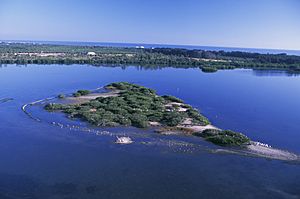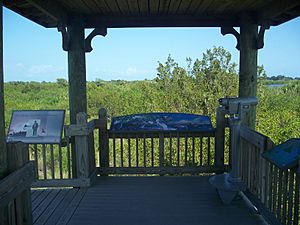Pelican Island National Wildlife Refuge facts for kids
Quick facts for kids Pelican Island National Wildlife Refuge |
|
|---|---|
|
IUCN Category IV (Habitat/Species Management Area)
|
|
| Area | 5,376 acres (21.76 km2) |
| Established | March 14, 1903 |
| Website | Pelican Island National Wildlife Refuge |
| Designated: | 14 March 1993 |
| Reference #: | 590 |
|
Pelican Island National Wildlife Refuge
|
|
 |
|
| Location | Indian River County, Florida, United States |
|---|---|
| Nearest city | Sebastian, Florida |
| Area | 3 acres (1.2 ha) |
| Built | 1903 |
| NRHP reference No. | 66000265 |
| Significant dates | |
| Added to NRHP | October 15, 1966 |
| Designated NHL | May 23, 1963 |
Pelican Island National Wildlife Refuge is a special place in the United States. It's a National Wildlife Refuge (NWR) located off the coast of Florida. This refuge is part of a larger area called the Everglades Headwaters NWR complex.
Pelican Island is a small island, about 3-acre (12,000 m2) in size. It also includes 2.5 acres (10,000 m2) of water around it. This important place was created by President Theodore Roosevelt on March 14, 1903. It was the very first national wildlife refuge in the United States! Its main purpose was to protect birds like egrets and other species. These birds were in danger because people were hunting them for their feathers.
Contents
Protecting Wildlife: How the Refuge is Managed
Pelican Island is part of a bigger group of protected lands. This group is called the Everglades Headwaters NWR complex. It covers about 8,000 acres (3,200 ha) in total. Other refuges like Archie Carr NWR are also part of this complex.
A new part of this complex was created in 2012. It includes a 10 acres (4.0 ha) donation and other lands. Some of these lands, about 100,000 acres (40,000 ha), are protected by "conservation easements". This means landowners still own their land. They can keep farming or ranching. But they agree not to build or divide the land. This helps protect the natural environment.
Pelican Island NWR is also listed as a Ramsar wetland. This means it's recognized internationally as a very important wetland area.
Pelican Island's Early Days: A Story of Protection
In the mid-1800s, more people moved to Florida. This put Pelican Island's bird populations in danger. Many beautiful birds were killed for their feathers. These feathers were used to decorate ladies' hats. At the time, these plumes were worth a lot of money.
A German immigrant named Paul Kroegel moved to Florida in 1881. He loved watching the pelicans on the island from his home. He became very interested in protecting the island and its birds. Since there were no laws to help, Paul decided to protect them himself. He would sail to the island and stand guard.
Some naturalists, or people who study nature, visited Paul Kroegel. One of them was Frank Chapman. He worked at the American Museum of Natural History. Chapman discovered that Pelican Island was one of the last places where Brown pelicans nested on Florida's eastern coast. These nesting spots are called rookeries.
Groups like the American Ornithologists' Union worked to pass laws. They wanted to protect non-game birds. Chapman and another advocate, William Dutcher, spoke to President Theodore Roosevelt. They asked him to protect Pelican Island. President Roosevelt agreed and signed an executive order. This made Pelican Island the first federal bird reservation. It was the first time the U.S. government set aside land just for wildlife.
Protecting the Island: Challenges Over Time
In the 1960s, Pelican Island faced new dangers. People wanted to sell the nearby wetlands and islands to builders. Local people fought hard to stop this. Groups like the Indian River Area Preservation League worked with the Florida Audubon Society. They convinced the State to include these islands in the refuge.
In 1963, Pelican Island was named a National Historic Landmark. This was because it was the first federal area created to protect wildlife. In 1968, Florida agreed to add almost 5,000 acres of mangrove islands to the refuge. Then, in 1970, Pelican Island became the smallest wilderness area in the National Wilderness Preservation System. The refuge has continued to grow. It has gained over 500 acres to protect it from nearby building. It also helps connect to the Archie Carr National Wildlife Refuge.
Today, building along the shoreline still threatens Pelican Island. This kind of development can harm the water quality. It can increase runoff from fertilizers and pesticides. This bad water quality can hurt the fish that the birds eat. More boats from development also disturb the birds. Protecting the shorelines helps keep this historic landmark special.
Pelican Island's Environment: What Makes it Special
The environment at Pelican Island includes its climate, land, and water.
Climate
Pelican Island has a subtropical and temperate climate. The average temperature is about 67 °F (19 °C). Summers are long, warm, and humid. Winters are short and mild. The area gets about 55 to 60 inches (140 to 150 cm) of rain each year. Tropical storms can happen from May to November.
Land Features: Topography and Geology
The land at Pelican Island changes in height. It rises sharply from the sea to about 15 feet (5 m). Then it drops slowly back down to the Indian River Lagoon. The land between the Indian River Lagoon and St. Sebastian River is 20 feet (6 m) high. Further west, an old sand dune rises from 20 feet (6 m) to 30 feet (9 m).
The landscape of Pelican Island was formed a long time ago. It's made of land from the Pleistocene (Ice Age) and Holocene (recent) periods. Wetlands, salt marshes, mangroves, and other swampy areas make up the land. The soil in the refuge is mostly sandy. It often contains shell fragments.
Clean Air and Water: Important for Wildlife
Good air quality is very important for the refuge. Air pollution can come from cars, power plants, and factories. The Indian River Lagoon area usually has good air quality. But sometimes, warmer temperatures can temporarily lower the air quality.
The Indian River Lagoon is a long waterway. It stretches about 155 miles (249 km). Many small rivers and canals flow into it. The Intracoastal Waterway is the deepest part of the Lagoon. The St. Sebastian River and Turkey Creek bring freshwater to the Lagoon. Water quality is also a concern. Things like cadmium, lead, and mercury can be found in the water. But inside the refuge, the water quality is generally better.
Amazing Wildlife at Pelican Island
Pelican Island National Wildlife Refuge is home to many animals. This includes hundreds of species of birds, fish, plants, and mammals. The wetlands here are a huge ecosystem. They support a wide variety of life. Fifteen species that are federally threatened or endangered live in the refuge. These include West Indian manatees and sea turtles.
The refuge also has two areas for wood storks. These birds, along with other wading birds, nest on the island. They thrive because there are so many fish. Pelican Island is a nesting ground for many birds. This includes brown pelicans, great egrets, snowy egrets, reddish egrets, great blue herons, little blue herons, tricolored herons, black-crowned night herons, American white ibises, glossy ibises, double-crested cormorants, anhingas, and American oystercatchers.
Visiting Pelican Island: What You Can See
You can only reach Pelican Island by boat or with a guided tour. It's important not to get too close to the nesting birds. Visitors are not allowed to get off the boat on the island.
If you visit during nesting season (late November to late July), you might see:
- Brown pelicans
- Wood storks
- White ibises
- Black-crowned night herons
- Double-crested cormorants
- Reddish, snowy, and great egrets
- Great blue, little blue, and tricolored herons
In winter, look for:
- Lesser scaup
- Blue-winged teal
- Mottled ducks
- Great northern divers
- Laughing gulls
- American white pelicans
- Red-breasted mergansers
Summer visitors might spot:
The Indian River Lagoon also has marine life. You might see sea turtles, dolphins, and manatees.
New visitor facilities opened on March 14, 2003. This was for the 100th birthday of Pelican Island and the National Wildlife Refuge System. A special stamp was even made to celebrate! The new facilities include:
- A 1/4 mile boardwalk
- An 18-foot (5.5 m) observation tower to view Pelican Island
- Two 2.5-mile (4.0 km) walking trails through the salt marsh
- Signs with information
- Restrooms and parking areas
These facilities are located west of Highway A1A on the north end of Historic Jungle Trail. Many groups worked together to create them.
Jungle Trail: A Historic Path
The historic Jungle Trail is a 7.8-mile sandy road. A part of it goes through the refuge. Citrus growers first built this road in the 1920s. It is now listed on the National Register of Historic Places.
Supporting the Refuge: Challenges and Staff
Like many wildlife refuges, Pelican Island has faced challenges with its budget. A lack of funding can make it hard to maintain the habitat. It also affects public education and recreation programs.
The staff at Pelican Island are part of the U.S. Fish and Wildlife Service. The number of staff members has sometimes decreased. This can limit the work done at the refuge. It can also affect how much the public can visit. For example, a wildlife festival that ran for 14 years had to end. The refuge manager, Paul Tritaik, mentioned in 2006 that staff reductions could lead to fewer activities and trail closures.







